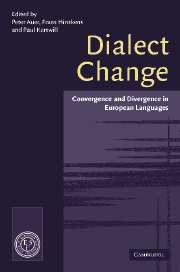Book contents
- Frontmatter
- Contents
- List of maps
- List of figures
- List of contributors
- Preface
- Map
- 1 The study of dialect convergence and divergence: conceptual and methodological considerations
- Part 1 Convergence, Divergence and Linguistic Structure
- 2 Internal and external factors in phonological convergence: the case of English /t/ lenition
- 3 Dialect/standard convergence, mixing, and models of language contact: the case of Italy
- 4 Convergence and divergence in grammar
- 5 Phonology, grammar, and discourse in dialect convergence
- Part 2 Macrosociolinguistic Motivations of Convergence and Divergence
- Part 3 Microsociolinguistic Motivations
- References
- Index
3 - Dialect/standard convergence, mixing, and models of language contact: the case of Italy
Published online by Cambridge University Press: 22 September 2009
- Frontmatter
- Contents
- List of maps
- List of figures
- List of contributors
- Preface
- Map
- 1 The study of dialect convergence and divergence: conceptual and methodological considerations
- Part 1 Convergence, Divergence and Linguistic Structure
- 2 Internal and external factors in phonological convergence: the case of English /t/ lenition
- 3 Dialect/standard convergence, mixing, and models of language contact: the case of Italy
- 4 Convergence and divergence in grammar
- 5 Phonology, grammar, and discourse in dialect convergence
- Part 2 Macrosociolinguistic Motivations of Convergence and Divergence
- Part 3 Microsociolinguistic Motivations
- References
- Index
Summary
Introduction
The main aim of this chapter is to examine some features of the relationship between convergence in a linguistic system and convergence, confluence, or interpenetration of forms from two varieties in use. On the basis of the most salient features of contact between the national language and the Italoromance dialects in Italy the applicability of a theoretical model designed to embrace the apparently very heterogeneous phenomena of language contact within a single concept will be discussed, namely Myers-Scotton's Matrix Language Frame model. This discussion should allow us not only to gain a better sociolinguistic understanding of the Italian situation but also, and above all, to focus on certain features of theoretical significance in the general treatment of convergence and contact.
Language Convergence and the Relationship Between Standard Language and Dialects
Let us begin with a few observations of a terminological and conceptual nature with regard to the two main terms involved, namely ‘convergence’ and ‘dialect’. I shall leave aside problems raised by the use of the term ‘convergence’ with reference to the language behaviour of individual persons in verbal interaction, such as situational accommodation between interlocutors. My employment of the term will be confined to the relationship between language varieties.
The term ‘language convergence’ is well known as one of the hobby-horses of historical linguistics.
- Type
- Chapter
- Information
- Dialect ChangeConvergence and Divergence in European Languages, pp. 81 - 95Publisher: Cambridge University PressPrint publication year: 2005
- 24
- Cited by



